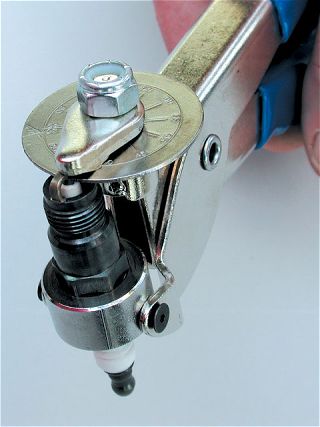 | An anvil squeezes the spark plug's ground electrode toward the center electrode with a shim between them, giving fast, consistent results once the tool's setting and process are dialed in. The ring that holds the body of the spark plug can be adjusted for longer or shorter plugs by flipping it on its mounts.
| An anvil squeezes the spark plug's ground electrode toward the center electrode with a shim between them, giving fast, consistent results once the tool's setting and process are dialed in. The ring that holds the body of the spark plug can be adjusted for longer or shorter plugs by flipping it on its mounts.
It had been a long time since I'd even thought about gapping spark plugs, because my car used platinum plugs that were shipped pre-gapped with plastic sleeves to protect the setting from impacts in handling. Then I helped out a friend by crewing for his drag car. Making more than 500 bhp from a sub-2.0L engine, plugs were changed after every two runs. Over the course of the weekend, that was a lot of plugs to gap, and the engine guy started asking about a set of gapping pliers. I had never heard of them, but it didn't take long to find Jacobs Electronics once I got back to the office.
Jacobs Electronics spark plug gapping pliers are useful for racers or full-time mechanics--this tool can save important minutes. Whether you're a drag racer, road racer, or autocrosser with a high-strung engine, there's a lot to do between rounds, and anything that lets it happen faster is valuable. If you have a six- or eight-cylinder engine, changing plugs takes even more time. For a mechanic charging $70 per hour to do tune-ups, minutes matter.
These gapping pliers are not foolproof. In fact, like most tools that increase the speed of a task, they add several new ways for a user to be a fool. Jacobs warned me that I'd have to get a feel for them, and that it would take some dial-in. I was told to check the results with a feeler gauge. This was good advice.
To begin, bend the spark plug's ground electrode away from the center electrode so it makes a 30- to 45-degree angle with the flat tip of the center electrode. This way, there is an even amount of yielding in the metal, and the spring-back of the ground electrode when it is bent will be consistent. Set the dial shim on the gapping pliers to a somewhat narrower setting than the desired result and set the plug in place. With the shim between the electrodes, squeeze the handles until the electrodes both make solid contact with the shim. Then check the gap with a feeler gauge.
Then, if it's your first time using the tool, think up new expletives. You'll be using all of them before you get your process dialed in. There's a definite learning curve. I was ready to put the pliers in a box and send them back to Jacobs, but thought I'd give it one more try. I'm not sure what the difference was, but suddenly it looked and felt right, and the gap came out at what I intended it to be. Then I did three more plugs and they were all correct, too. It works after all, and, once set up, in a fraction of the time it takes to gap plugs manually.
Jacobs' spark plug gapping pliers seem well made, with one exception: The adhesive used to hold the molded plastic grips to the handles eventually let go of the plastic.
The setup time keeps the spark plug gapping pliers from being a big winner for just one set of four plugs, but if you find yourself gapping 20 or more plugs in a day, they are definitely worth a look.
